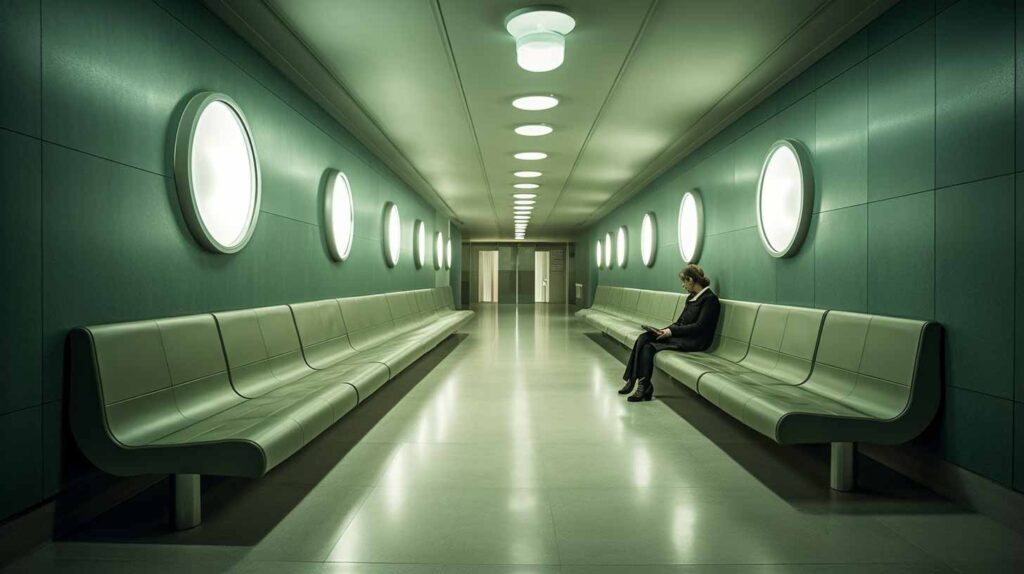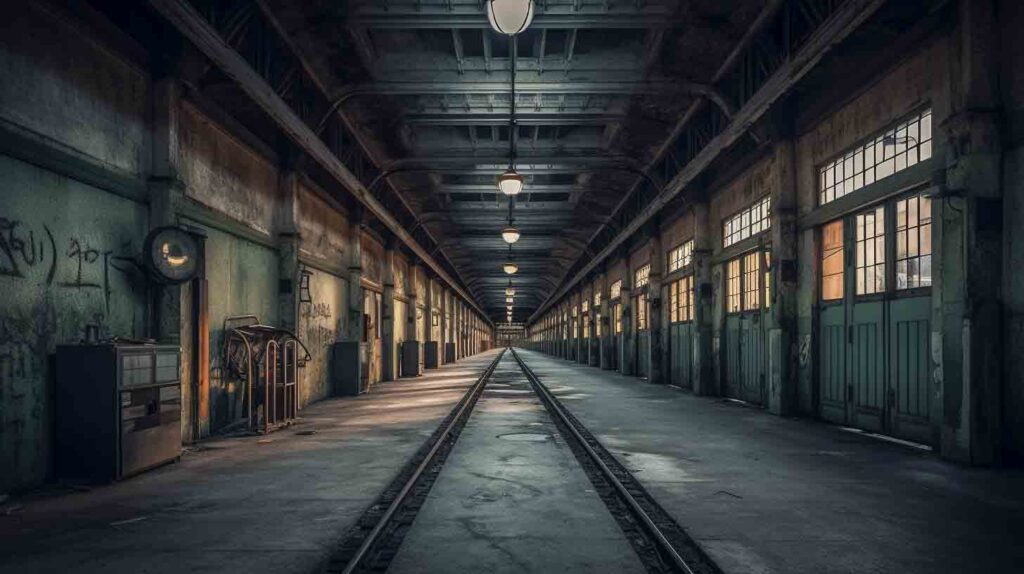Have you ever found yourself in a room that felt oddly unfamiliar yet strangely comforting? A space that feels lost in time, yet nostalgic — as if you’ve been there before.
Or perhaps you’ve wandered through a video game landscape that seemed to exist somewhere between the real and the unreal? If so, you’ve encountered what we call a ‘liminal space’ – a concept as elusive as it is captivating.
We’re about to plunge into the corridors of the in-between, the thresholds of the undefined, and the transitions that hold a unique place in architecture, psychology, and, yes, even video games. These liminal space images can be hauntingly empty, filled with a sense of suspended time, but they also have potential and layered meanings.
Here’s the definition of liminal space as it pertains to architecture and psychology.
What is a Liminal Space in Architecture?
In architecture, a liminal space refers to a transitional or transformative space. It is often characterized as a ‘threshold’ or an in-between space that connects two different areas or states of being. Liminal spaces can be physical, such as hallways, stairwells, or doorways that act as transitions from one room to another. However, they can also be metaphorical or psychological, encompassing the transitional stages we navigate during periods of change, growth, or uncertainty.
The term ‘liminal’ comes from the Latin word ‘limen,’ meaning ‘threshold.’ Liminal spaces are thought to have a unique impact on our perception and experience because they exist on the edges, between the defined boundaries of our everyday world. They often evoke feelings of disorientation, eeriness, or an uncanny sense of familiarity because they are places we pass through, not places where we typically reside.
In the world of architecture and design, understanding and utilizing liminal spaces can provide unique opportunities for creating dynamic, engaging environments that prompt reflection, exploration, and a deeper interaction with the built environment.
Observing liminal space images is important because it helps us understand how we experience and interact with our environment and ourselves. It lets us see the little details in our surroundings and how they affect our mood, behavior, and mindset.
In regards to psychology and “mindset”, these spaces can help us deal with transitions and changes in our lives. It gives us a better perspective and helps us prepare for whatever’s coming next, whether it’s a new job, a new home, or a new perspective on life.
But where did this idea of ‘liminal space’ or ‘liminality’ start?
Perhaps you’ve heard of The Backrooms…
“The Backrooms”: Glorifying Liminal Space in Architecture
In summary, The Back Rooms (or The Backrooms) was this creepy internet phenomenon that’s been around for a while. The Backrooms is basically a hypothetical alternate reality that some people believe they’ve accidentally stumbled into.
It all started on the 4chan website back in 2019, where someone posted a picture of a yellow, low-ceilinged room that they claimed represented the place where they’d been trapped for an extended period of time. The person who posted the picture claimed that they had accidentally ended up in this strange alternate universe while trying to do some work at their office.

From there, people started sharing similar stories about finding themselves in seemingly endless, maze-like structures that all looked like they were from the 70s or 80s. People started calling these places “The Backrooms” and describing them as both creepy and unsettling.
Since then, The Backrooms have become a popular subject of online horror stories, videos, and games. People have even created their own theories about the history and nature of The Backrooms, speculating that it might be a glitch in reality or a supernatural dimension that exists parallel to our own.
Whether or not The Backrooms are real or just a figment of people’s imaginations, it’s definitely a fascinating and spooky concept.
As designers, we’re responsible for constantly questioning the experiential part of any space we design. How does the space we’ve designed make people feel?
In regard to liminal space in architecture, we need to ask the same question.
Why are Liminal Space Images so Unsettling?
Liminal spaces, being on the cusp of two environments or states of being, often induce a sense of discomfort or unease, but why is that? Unraveling this mystery requires a deep dive into the nexus of architecture and psychology.
At their core, liminal spaces exist as transitional zones, on the threshold between ‘here’ and ‘there,’ ‘before’ and ‘after.’ This inherent ambiguity can make these spaces feel disorienting or unsettling. As humans, we crave certainty and predictability; it gives us a sense of control and safety. The nebulous nature of liminal spaces disrupts this certainty, launching us into a realm where the rules we usually rely on might not apply. This disorientation is particularly strong in places like airports or hallways, where the sense of transience and impermanence is palpable.
Liminal spaces also often lack the signs of life and activity we associate with ‘place’. An empty parking lot at night, a deserted hallway, or an unoccupied waiting room — these places seem almost suspended in time, devoid of the human interaction and purpose that usually gives a space its identity. This absence of familiar markers can induce feelings of alienation or loneliness, adding to the unsettling atmosphere.

Architecturally, liminal spaces often incorporate elements like long, monotonous corridors, vast, impersonal lobbies, or narrow, poorly lit stairwells that can provoke discomfort. The scale, lighting, and spatial layout can play a significant role in evoking a sense of unease. A corridor that’s too long can induce a feeling of endlessness, while a staircase that’s too dim can trigger anxiety.
From a psychological perspective, liminal spaces often mirror the subconscious process of transformation and change. Just as these spaces exist in a state of ‘in-between’, so too do we during times of personal transition. This can make them uncomfortable yet strangely compelling, as they mirror our own internal struggles with change and uncertainty.
Interestingly, this unsettling quality of liminal spaces can also be harnessed in positive ways. It can prompt introspection, self-discovery, and open us up to new possibilities. In art and literature, these spaces are often used to symbolize transformation, growth, or the journey into the unknown.
In conclusion, the unsettling nature of liminal spaces arises from their transitional and ambiguous character, the disorientation they can induce, and the psychological mirror they hold up to our own experiences of change and uncertainty. This unease, however, is part of their intrigue and charm, making them a rich topic of exploration in both architecture and psychology. Despite the discomfort they can provoke, they are integral to our built environments, embodying the inherent fluidity and dynamism of life.
What are the Characteristics of a Liminal Space in Architecture?
In the realm of architecture, liminal spaces exist in the thresholds, offering transitional zones between different environments or states of being.
But what sets these spaces apart? What characteristics define them?
The most defining characteristic of a liminal space in architecture is its transitional nature. These spaces exist on the brink, linking two different areas, environments, or states of being. They are not destinations in themselves but conduits that guide individuals from one place to another. This can be as grand as an airport terminal, facilitating a transition between countries, or as intimate as a hallway in a home, guiding movement between rooms.
Secondly, liminal spaces are inherently ambiguous.
They blur boundaries, often mingling elements of the environments they connect. An arcade, for example, bridges the interior and exterior, offering protection like an interior space while still exposing one to the outside environment. This ambiguity can create a sense of disorientation or uncertainty, but also excitement or anticipation.

Spatially, liminal spaces can vary greatly, from narrow corridors and staircases to expansive lobbies and plazas. However, they often share a sense of direction or movement. They guide the flow of people, using architectural cues to subtly direct individuals from one place to another. Their design frequently emphasizes the axis of movement, often employing a linear or path-like organization.
From a sensory perspective, liminal spaces can offer a unique experience, marrying elements of the environments they connect. A balcony, for instance, provides a view and exposure to natural light like an exterior space while maintaining the comfort and protection of an interior space.
Similarly, the sounds, smells, and temperatures in these spaces often mix elements of both connected environments.
Liminal spaces also tend to reflect a shift in purpose or activity. A threshold between a bustling kitchen and a tranquil bedroom, for example, marks a change not just in space but also in function and atmosphere. This shift can be underscored through changes in material, color, lighting, or spatial proportions.
From a social perspective, liminal spaces often offer opportunities for informal interaction and observation. Balconies, terraces, or staircases can provide vantage points for observing the surroundings. On a larger scale, transit spaces like train stations or bridges can serve as melting pots of diverse social interactions.
Despite their often-overlooked status, liminal spaces are key in shaping the overall architectural experience. They set the rhythm of movement, offer moments of pause, and heighten the sense of arrival. Through their design, they can either smooth or dramatize the transition, making the journey through a building a rich, layered experience.
While liminal spaces in architecture may vary in form and scale, they share a unique set of characteristics. They exist in transition, blur boundaries, guide movement, offer sensory variety, reflect shifts in function, provide social opportunities, and shape the overall architectural journey. Despite their often understated role, they are vital in creating meaningful, engaging built environments.
Why do liminal spaces look familiar?
Liminal spaces often strike us with a haunting sense of familiarity, almost as if we’ve been there before, even when we haven’t. This feeling can be both eerie and comforting, like revisiting an old memory. But what makes these transitional spaces seem so familiar?
Let’s unravel this paradoxical quality of liminal spaces in architecture.
Liminal spaces are ubiquitous and fundamental to the functioning of our built environments. Hallways, staircases, doorways, elevators – these spaces form the skeleton of almost every building. They enable movement and connect different areas, forming the underlying matrix on which the more noticeable spaces are organized. Due to this universality, we encounter these spaces frequently in our daily lives, across different building types and cultural contexts. This constant exposure to similar spatial layouts and design elements creates an inherent sense of familiarity.

Liminal spaces also often embody common architectural tropes and design elements. For instance, the image of a long corridor with doors on either side, or an empty parking lot under a night sky, has been replicated in countless buildings, films, and photographs. These repeated visual patterns can create a subconscious sense of recognition, making even a new space seem strangely familiar.
The universality of the experiences and emotions associated with liminal spaces also contributes to their familiarity. The feeling of anticipation before opening a door, the sense of arrival when stepping into a lobby, or the quiet introspection during a solitary walk down a corridor – these are universal human experiences. Regardless of the specifics of a space, these shared emotions can make liminal spaces feel relatable and familiar.
Furthermore, liminal spaces often lack a strong individual identity. They are usually designed to be neutral, allowing the function or character of the adjacent spaces to shine. This neutrality can make them seem generic, blending different instances of liminal spaces into a common, familiar archetype in our minds.
On a deeper level, liminal spaces mirror our psychological experiences of transition and change. Just like these spaces, we often find ourselves in the ‘in-between’ – between jobs, relationships, homes, or stages of life. These internal liminalities are a universal part of the human experience, further strengthening the sense of familiarity we associate with liminal spaces.
The eeriness or unease we sometimes feel in liminal spaces can also play a role in this perceived familiarity. Our brains are wired to remember unsettling or unusual experiences as a survival mechanism. Thus, the distinct emotions provoked by liminal spaces can etch them deeper into our memories, making them seem more familiar when we reencounter them.
Ultimately, the familiarity of liminal spaces arises from their ubiquity in our built environments, the commonality of their design elements, the universality of the experiences they evoke, their neutral character, their reflection of our internal liminalities, and the distinct emotions they provoke. This underlines the psychological depth of these seemingly mundane spaces, making them a rich topic of exploration in architecture.
13+ Examples of Liminal Space Images in Architecture
To give you a practical examples in architecture, these liminal space images capture what we might see in the real world.
Doorways and Thresholds
These are classic examples of liminal spaces – they act as the transition point between two distinct spaces, like the inside and outside of a building or two rooms.



Doorways and thresholds are perhaps the most literal manifestations of liminal space in architecture. They demarcate the boundary between two distinct spaces—indoor and outdoor, private and public, or even between different rooms within a building.
Crossing a threshold often signifies a shift in purpose or status, both physically and psychologically. This shift might be subtle, such as the transition from a bustling kitchen to a quiet bedroom, or more significant, like entering a sacred space.
Psychologically, doorways can create anticipation and a sense of mystery about what lies beyond. They also serve as a symbolic “rite of passage” in many cultural contexts, reinforcing the significance of transitions in our lives.
The design of doorways, in terms of scale, detail, and materiality, can significantly enhance these psychological impressions, making every crossing a memorable experience.

Hallways and Corridors
These are transitional spaces that connect different rooms or sections of a building. They’re often places we pass through without much thought, but they’re crucial in defining the flow of a structure.



Corridors and hallways are quintessential examples of liminal spaces. These serve as transition points, guiding individuals from one area to another.
Psychologically, hallways might evoke feelings of anticipation or apprehension, given their linear nature and singular direction. The design and illumination of these spaces can significantly influence these feelings.

Staircases and Elevators
These spaces are all about vertical transition, taking us from one level to another. They can be seen as liminal because they’re in-between destinations rather than destinations themselves.



Staircases and elevators are dynamic liminal spaces, physically moving individuals between levels. The feeling of transition is more pronounced due to the perceptible change in altitude.
Staircases, especially spiral ones, may evoke a sense of mystery and anticipation, while elevators can induce suspense or tension due to their confined nature.

Bridges
Bridges connect two separate physical spaces (like two sides of a river or valley), acting as a transitional or liminal space.



Bridges, by design, are meant to span physical obstacles and connect two distinct places. They often symbolize the journey or transition between these spaces, making them potent liminal structures in architecture.
The very act of crossing a bridge can evoke an array of emotions—excitement about reaching the other side, apprehension about what lies ahead, or even a sense of awe and marvel at the bridge’s structural elegance.
For pedestrian bridges, particularly, the slower pace allows for contemplation and appreciation of the transition and the views it offers. Bridges can also serve as meeting points, where people from different sides come together, creating a shared social space. Whether grand and iconic, or small and modest, the design of bridges greatly influences the psychological experience they provide.
This makes them a significant element in the architectural and urban landscape.

Lobbies or Waiting Areas
These are spaces where we spend time in transition, waiting for something to happen – like an appointment or meeting.



Waiting areas, whether in offices, hospitals, or transportation terminals, represent another fascinating example of liminal space in architecture. These spaces are designed for temporary occupancy, where individuals pause and wait before moving on to their final destination.
Psychologically, they may evoke feelings of anticipation, impatience, or even tension, depending on the context. However, thoughtfully designed waiting areas can mitigate such feelings.
By incorporating elements like comfortable seating, calming color schemes, and engaging distractions like art or views, architects can transform these liminal spaces into pleasant, restorative environments that reduce stress and enhance well-being.

Airports and Train Stations
These are transient places full of people in the process of coming or going. They exist almost solely to facilitate transition from one place to another, making them powerful examples of liminal spaces.



Airports and train stations are among the most dramatic instances of liminal space in architecture. They embody the notion of transience and temporary stay, acting as gateways that usher people from one place to another. These spaces often induce mixed feelings—there’s excitement or eagerness for the journey ahead, but also anxiety or a sense of loss due to departures.
The vastness and dynamism of these spaces can lead to sensations of being ‘in-between’ or in a state of ‘non-place.’ Their design plays a crucial role in managing the flow of people and creating an environment that caters to the needs of those in transit.
Architectural elements that enhance comfort, ease stress, and provide a sense of direction can greatly improve the experience of these liminal spaces.

Arcades and Covered Walkways
These are liminal spaces that function as transitions between the indoors and outdoors. They provide a sense of enclosure and protection while still being connected to the outdoor environment.



Arcades and covered walkways create intriguing liminal spaces that act as a buffer between the interior and exterior environments. They provide shelter and continuity, guiding pedestrians along a path while offering a sense of protection from the elements.
These spaces create an interplay of light and shadow, creating a rhythm that can evoke feelings of calm and comfort.
Psychologically, they offer a transitional experience that combines the openness and variability of outdoor spaces with the safety and structure of indoor environments.
The design of arcades and walkways—from the height and width to the detailing of columns and the quality of materials—can significantly influence the experience and emotions evoked in these liminal spaces.

Each of these spaces, while often overlooked in our day-to-day lives, plays a crucial role in our experience of the built environment and our journey through it.
Ultimately, they’re important because they facilitate the flow and functionality of more important architectural spaces. They guide people from one place to another, creating a sense of coherence and navigability in the architectural layout. Rather than serving to create “moments of pause” for building occupants and pedestrians, they often yield themselves to function as circulation spaces.
How can I create liminal space with AI?
As AI continues to rapidly evolve, architects and designers can experiment with different types of AI art generators to create liminal spaces using AI. Be sure to check out my post below to see how you can get started with using AI art generators to create your own examples of liminal space in architecture!
FAQ: Liminal Space in Architecture
While there are plenty of ongoing conversations that you can find via a quick Google search about liminal space, I want to break down some of the more specific questions as they pertain directly to architecture.
This section will cover some of my own thoughts and opinions to help generate discussion around these topics.
Are abandoned buildings liminal space?
Yes, abandoned buildings can be seen as liminal spaces. They exist in a state of transition, no longer serving their original purpose, yet not having transitioned to a new one. They often evoke feelings of eerie nostalgia, uncertainty, or even fear, as they straddle the line between the past and the present, occupied and unoccupied.
What is liminal void?
The term “liminal void” isn’t widely recognized in architecture or psychology. However, in general discourse, it might refer to a transitional space that feels empty or directionless, possibly provoking feelings of disorientation or aimlessness.
Are bathrooms liminal?
Bathrooms can indeed be considered liminal spaces. They serve as a place of transition between states of cleanliness and provide a private refuge within a public or semi-public environment. In terms of psychology, bathrooms can evoke a range of emotions, from comfort and relaxation to vulnerability.
Is a mirror a liminal space?
A mirror, while not a physical space, can indeed symbolize a liminal space. It presents a threshold between reality and reflection, creating an illusion of another space beyond the surface. Mirrors can stimulate contemplation and self-awareness, making them psychologically potent.
Can anything be a liminal space?
Not exactly. While a wide variety of physical and conceptual spaces can be considered liminal, the key factor is that these spaces must exist at a threshold or in-between state, facilitating a transition or transformation.
Is deja vu a liminal space?
Deja vu is not a space but a psychological phenomenon where one feels that a current event has happened before. However, the concept shares a similarity with liminal spaces in its sense of uncanniness and the feeling of being betwixt and between.
Can liminal spaces be comfortable?
Absolutely. While liminal spaces often evoke feelings of anticipation or uncertainty, they can also provide comfort. This largely depends on the design elements employed in the space, such as lighting, color, material, and spatial organization.
Who created the concept of liminal space?
The term “liminal” comes from the Latin word “limen,” meaning “threshold.” The concept of liminality was first developed by anthropologist Arnold van Gennep in the early 20th century and was later expanded upon by Victor Turner. In architecture, it has been adopted to refer to spaces that exist in-between.
What is the psychology behind liminal space?
Liminal spaces can prompt a variety of psychological responses, typically revolving around feelings of transition, anticipation, uncertainty, or being ‘in-between.’ They can induce introspection, excitement, discomfort, or nostalgia, depending on the individual and the context.

Jon Henning
Hi, I'm Jon. I write about emerging technology in architecture, engineering and design, and I want to help you push boundaries with the latest tech trends in the AEC industry.
Want to step up your AI Architecture Visualizations? Grab a copy of my FREE eGuide, which contains over 100 examples of AI Architecture prompts to use with MidJourney 5.


